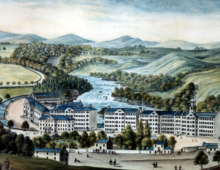Was change in medical practice revolutionary or evolutionary during the Age of Revolution? Enquiry focus 3
Phrenology
Suitable for students aged 14+
1. Watch
Ask students to watch the Phrenology video. Ask them to write down any important points about the development of phrenology during the Age of Revolution.
If you are watching with the students, pause the video to help them reflect on the questions below as well as considering the types of questions the historians are asking. Highlight the way Dr Sleigh links the science of phrenology with other radical ideas.
Can students answer the following questions?
- What were the ideas behind phrenology?
- What questions did the science of phrenology seek to answer?
- Why did some people think that the ideas of phrenology were radical?
2. Test
Students can try this multiple choice quiz to see how much they have remembered from the video. Students working at home can save their answers as a PDF and email them to teachers.
3. Research
In the video, Dr Sleigh discusses the importance of Edinburgh to the phrenological bust and medicine in general. Ask students to conduct some independent research on the importance of Edinburgh to the history of medicine and produce a fact file for other students to use. They should think about:
- the importance of medical education in Edinburgh
- how medical practitioners worked together in the city
- why it was often seen as a ‘radical’ city.
This is a good opportunity for students to spend some time looking at the importance of one place and a community of people that moved the study of medicine on. They could be asked to consider if there are other examples of this in the study of the history of medicine.
4. Connect
New ideas and radical social change are discussed in the video. Ask students to use the links below to look at two other objects from the Revolutionary collection:
For each object, students make notes about how it:
- shows people having new ideas and beliefs
- links to the idea of changing the way the world worked.
Different groups of students could be asked to explore different objects from the Revolutionary collection to develop a sense of the period.
5. Think
Phrenology has now been discredited, but the bust still reveals something about the ideas and attitudes that were popular at the time. Can students think of other examples of ideas they have studied which have later been shown as false? Is it worth studying ‘dead ends’ in history? In class this could be completed through paired or small group discussion. If students are studying at home they could be encouraged to use email or virtual chats to discuss these ideas.
6. Reflect
This enquiry focuses on the patterns of change in medical practice that we can see during the Age of Revolution and whether this was revolutionary or evolutionary. Ask students to produce a diagram to show their thoughts about what sort of change phrenology brought. They could use a diagram like this example.
Explain that the centre of the diagram represents an evolutionary change i.e. something slow and steady; possibly with some points of regression (backwards movement). The outside of the diagram represents revolutionary change i.e. something fast and explosive which changed peoples’ lives or ideas rapidly.
There are five points between the centre of the diagram and the outside. First, students decide whether they think the change brought by the phrenological bust was evolutionary, revolutionary or somewhere in between on a scale of 1-5 and mark this on the diagram with a cross. They then add brief notes to explain why they have chosen to give the phrenological bust this score.
As they study more objects from this overall enquiry, they will add to this diagram to get an overall impression of whether they think medical change in the period was evolutionary or revolutionary. As students develop their diagram of the pattern of change encourage them to think about the criteria they are using for deciding whether a change is evolutionary or revolutionary. They should also be encouraged to explore other themes to broaden their knowledge and understanding of the period.
7. Extend
Historians are increasingly using new technology in order to collate and study sources. Read this blog post about the work which is being done to digitise documents from the Newport Uprising in 1839 (linked to the ‘Rebecca riots’ object in Section 4 above). What uses for new technology can students think of? Could they apply some of this to their study of the history of medicine?
The ideas behind using technology to further the study of history could be a focus for a class project.
Try the other enquiries in the series
Was change in medical practice revolutionary or evolutionary during the Age of Revolution?
Enquiry focus 1 – Vaccination
Enquiry focus 2 – The Old Operating Theatre
Enquiry focus 3 – Phrenology
Enquiry focus 4 – The stethoscope
Consolidate your thinking – Change in medical practice during the Age of Revolution
What factors drove change in medical practice during the Age of Revolution?
Enquiry focus 1 – The kymograph
Enquiry focus 2 – Anatomical research and Charles Bell
Enquiry focus 3 – Surgical instruments
Enquiry focus 4 – Early anaesthetics
Consolidate your thinking – Drivers for change in medical practice during the Age of Revolution


